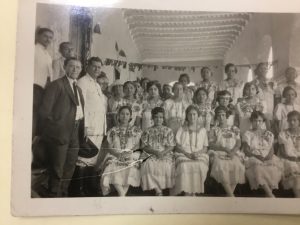Professor of History at NYU Barbara Weinstein recently visited the RBML to research Frank Tannenbaum, an organizer in the IWW in his youth who later taught criminology at Cornell and Latin American history at Columbia. Below Weinstein discusses some of her discoveries in the (vast) Tannenbaum papers as part of her project, Frank Tannenbaum—Anarchist, Criminologist, Historian: An Intellectual Biography.
***
What brings you to Columbia’s Rare Book & Manuscript Library?
The figure at the center of my project, Frank Tannenbaum, was both an undergraduate and a professor of history at Columbia, and left his very large collection of papers (100 boxes) to the RBML. My three previous books were all based mainly on collections in Brazilian archives, and as much as I love having an excuse to travel abroad, I also enjoy waking up in my own apartment with no jetlag, getting on the 1 train, and immediately sitting down with my sources.
How long have you been using RBML materials (for this and/or previous research)?
Since I’m a historian of Latin America, none of my previous projects had brought me to the RBML. I started doing the research for the Tannenbaum project six years ago, and I thought I would finish it within a year or two at the most. But the collection turned out to be so large and so rich that my progress was slower than I expected. And then the pandemic came. There were so many people and places I missed during the pandemic years, and one of the places I missed the most was the RBML.
What have you found? Did you come here knowing this material was here?
I knew, of course, that Tannenbaum’s papers were archived at the RBML, and I knew that about 20 of the boxes contained his correspondence (including, I’m happy to say, not just letters he received but letters he wrote—early on he got into the habit of keeping carbon copies of his correspondence, bless him). But only the very first box of his correspondence was fully indexed, so I couldn’t know before starting the research with whom he had been corresponding over the years. As for the other 80 boxes, they had subject headings but it wasn’t until I opened the boxes that I really was able to figure out what they had inside. Predictably, some boxes were like treasure chests—almost overflowing with “valuable” material—and others were a little disappointing. But I always found something of interest, even in the less exciting boxes. For example, among a batch of newspaper clippings that were mainly boilerplate reviews of one of Tannenbaum’s 15 books, I found a (very positive) letter of recommendation he wrote for W.E.B. Du Bois, who was applying for a grant to go to Germany in 1934 to study that country’s vocational training system. That was so interesting in so many ways.

What have you found that’s surprised or perplexed you?
My biggest surprise was what I learned about Tannenbaum’s personal life. I started the project with the assumption that he had been married once, relatively late in life, and had no children. It turns out that he married for the first time in his early 20s, while still an undergraduate, and had two children with his first wife. When they divorced in 1929, he relinquished his parental rights and the children were adopted by his ex-wife’s new husband. As far as I know, Tannenbaum never saw them again. When I found this out, I was genuinely shocked, and I think for the first and only time since I’ve been doing research at the RBML, I decided to go home early that day.
The discovery that has me most perplexed is a project that Tannenbaum never finished that was supposed to be a three-volume history of Peru. I found a 300-page manuscript of the first volume in a “Peru” box, but it remains unpublished, and as far as I can tell, he never wrote the other two. I have some inkling of why a project to which he had devoted a great deal of research and writing time never came to fruition, but it’s still a bit of a mystery.
What advice do you have for other researchers or students interested in using RBML’s special collections?
The digital age has accustomed us to being able to quickly search and find the things we’re looking for, but if a researcher is using a very large collection—one like the Tannenbaum papers with a hundred boxes—there’s no substitute for patience. And even a rather ordinary-looking source can turn out to be very useful. One box description referred to “Diaries,” so I had hoped I would find volumes full of Tannenbaum’s personal revelations. In fact, they all turned out to be appointment books with brief entries for meetings or trips or dinners. Not what I had hoped, but they still proved to be very useful in helping me figure out, for example, who he talked to during his many trips to Mexico, or how regularly he met with his friend and editor, Alfred Knopf. So even a “disappointment” can turn out to be a significant source.
I want to close by expressing my appreciation for the RBML staff, and especially for all the efforts they made to allow researchers to start coming back as conditions improved and the pandemic very slowly came to an end (of a sort).